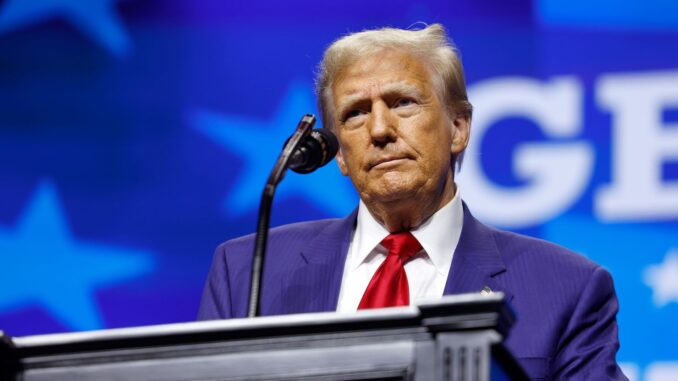
Why Are Democrats Having Such a Hard Time Beating Trump?

Whatever happens Tuesday, it’s fair to say this campaign has not gone as smoothly as Democrats expected.
In the wake of the midterms, Donald J. Trump appeared to be finished. He may still lose, of course, but he clearly wasn’t “disqualified” — as many expected — by Jan. 6, several criminal indictments or an overturning of Roe v. Wade by his Supreme Court appointees. If voters disqualified any candidate in 2024, it was the sitting president, not the felon who attempted to overturn the last election.
How is Mr. Trump still so competitive? The simplest answer is that the national political environment just isn’t as conducive to a Democratic victory as many might imagine.
Democrats clearly face headwinds in this election. In the last New York Times/Siena College poll, only 40 percent of voters approved of President Biden’s performance, and only 28 percent said the country was heading in the right direction. No party has retained control of the White House when so many Americans were dissatisfied with the country or the president.
The polls suggest the challenge for Democrats runs even deeper. For the first time in decades, Republicans have pulled even or ahead in nationwide party identification. Polls also find Republicans with the an edge on most key issues — with democracy and abortion standing as significant exceptions.
The Democrats’ challenge appears to be part of a broader trend of political struggles for ruling parties across the developed world. Voters appear eager for change when they get the chance. The ruling parties in Britain, Germany, Italy, Australia and most recently Japan all lost power. Mr. Trump himself lost four years ago. France and Canada might well join the list.
The specifics vary from country to country and party to party, but much of the story is the same: the pandemic and upheaval that followed. Nearly everywhere, high prices and the fallout from the pandemic left voters angry and resentful. It discredited ruling parties — and many of them weren’t especially popular at the outset.
This gradually eroded and sometimes shattered trust in government officials, liberal elites and the media. When prices rose, it frustrated millions of younger and low-income voters who saw their savings, purchasing power, housing opportunities and hopes dwindle.
In the United States, post-pandemic disillusionment and frustration took a toll on Democrats. The party championed a tough response to the virus, including mask and vaccine mandates, school closures and lockdowns. It had backed the Black Lives Matter movement, argued for a more liberal border policy, sought to reduce greenhouse gas emissions, and spent trillions on stimulus. As the pandemic ended, all of this quickly became a liability.
Unlike other governing parties, Democrats have the Trump card to play. Along with abortion, it could be enough to allow Democrats to prevail. That’s exactly what happened in the 2022 midterm elections. But even if Kamala Harris emerges as the winner, it will not necessarily be a victory for progressives.
More than at any time over the last 16 years, Democrats are playing defense on the issues. They’ve moved to the right on immigration, energy and crime. They de-emphasized the traditional liberal push to expand the society safety net, which was eclipsed by the urgency to reduce prices.
Whatever the outcome, a long period of liberal ascendancy in American politics might be waning.
The end of an era?
Since 2008, Democrats and liberalism have been dominant in American politics.
Democrats won the popular vote in four straight presidential elections. When they held full control of government, they enacted the Affordable Care Act, Dodd-Frank and the CHIPS Act; they saved the auto industry and spent billions on renewable energy, infrastructure and more.
Liberalism has been ascendant in the culture as well. The period was marked by a series of popular movements on the activist left, from the Obama ’08 campaign to Occupy Wall Street, Black Lives Matter, #MeToo, the Bernie Sanders campaign and calls for a Green New Deal and Medicare for all.
The election of Mr. Trump didn’t stop this outpouring of liberal energy. Instead, it accelerated it. His election alarmed and outraged millions, who saw him as racist, sexist and a threat to democracy. The murder of George Floyd and the pandemic only added to the outrage, leading to a vigilant and righteous new left that preached antiracism and coronavirus restrictions. It culminated in a wave of protests and so-called “woke” progressive activism on race and gender.
Over just the last few years, all of this liberal energy suddenly seemed to vanish. The backlash against pandemic restrictions and the woke left gradually went mainstream, and even divided liberal institutions. Trust in the media, “experts” and scientists plunged. Younger Americans took to social media — perhaps with the help of algorithmic changes — to vent their frustrations with an aging president, high prices, lost opportunity and anger at a system that wasn’t working for them.
At the same time, the events that followed the pandemic took a serious toll on the case for liberalism, whatever the precise merits of the arguments. Inflation and high interest rates could be blamed on high government spending stimulating excessive demand. High gas prices could be blamed on suspending drilling permits and the termination of the Keystone pipeline project. A surge of migrants could be blamed on the administration’s looser border policy, which became politically untenable; homelessness, crime and disorder made the case for “law and order.”
On issue after issue, Democrats have responded by moving to the right. Most obviously, Ms. Harris had to back away from positions she took when the progressive cultural ascendancy was near its peak in 2019 — a ban on fracking, Medicare for all and so on. But the Democratic shift isn’t simply about backing away from positions taken during a Democratic primary. Across the board, Democrats have de-emphasized policies they preached with confidence to a general electorate only a few years ago.
On immigration, Ms. Harris’s first priority is a border security bill, rather than the comprehensive solution long backed by Latino activists and even centrist Democrats a decade ago. On energy, Democrats brag about increasing domestic oil production. On crime, Ms. Harris’s record as a prosecutor is now an asset.
The traditional Democratic program to expand the social safety net has played a diminished role in the campaign. In her speech at the Democratic convention, Ms. Harris didn’t mention the unfinished business of Obama-Biden era liberalism: paid family leave, an expanded child tax credit, student loan forgiveness, universal pre-K or free community college. Instead, she promised a conservative-sounding tax break for small businesses. The liberal policies she does advocate on the campaign trail tend to be far smaller than the Affordable Care Act or those contained in Build Back Better.
If there’s any poll question that captures the swing toward a more conservative environment, it’s the question of which party (or candidate) would do the best on the issue that’s most important to your vote. All cycle, polls have shown Republicans and Mr. Trump with an advantage on this measure. Indeed, the polls show Mr. Trump and Republicans with an advantage on most issues.
This rightward shift is evident in party identification as well. This year, high-quality polls found that the nearly two-decade-long Democratic advantage in party identification evaporated or even reversed. This year, the biggest names in political polling — Pew Research, Gallup, NBC/WSJ, Times/Siena, and so on — have all found the Republicans edging ahead of the Democrats for the first time since 2004, if ever.
The trend in party registration is similar, with Republicans rapidly gaining ground across the country. All of the battleground states with party registration — Arizona, Pennsylvania, Nevada and North Carolina — will probably have more registered Republicans than Democrats in November, even if Ms. Harris wins with support from the growing ranks of the unaffiliated.
In the longer sweep of the last 16 years, this is an enormous change. When Democrats came to power in 2008, they confidently entered the White House with arguably a 40-year-long list of policies to address a backlog of problems, from health care and climate to immigration and unions. They enacted much of this agenda over the last 16 years, but many voters still aren’t satisfied with the state of the country.
A lost conservative moment?
The loss of Democrats’ advantage in party identification and the growing Republican edge on the issues signaled that there was a good opportunity for Republicans to win this election.
If it weren’t for Mr. Trump’s liabilities, it’s easy to imagine how Republicans could have won decisively in the manner of a “change” election, like in 1980 or 2008, when American politics lurched left or right with lasting consequences. Mr. Trump might still do so, but clearly his challenges will make it harder in important ways.
If Mr. Trump wins, this will be the likeliest explanation, rather than his own political popularity. After a period of Democratic predominance, the upheaval during and after the pandemic, along with the response, left too many voters disillusioned with Democrats, and unwilling to give the party another chance — despite their serious reservations about Mr. Trump.
If he loses, the explanation will be equally simple: It was his own conduct on Jan. 6 and the Supreme Court’s decision to overturn Roe that cost him a winnable election. In that event, a Harris victory still might not augur well for the hopes of progressives. Democrats might keep their winning streak going, but when historians look back they might conclude that the liberal ascendancy had already come to an end


Be the first to comment